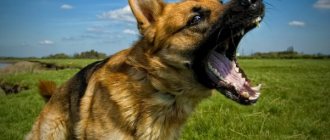Rat poison
“Dogs are being poisoned en masse!”
- similar statements are heard from environmentalists. And sometimes the methods used for bullying are very different. Often, even poison against rats is used. Eating pure poison is rare. After all, the bait itself is quite unattractive to the animal. The risk of poisoning with such a substance increases significantly if we are talking about special baits created on the basis of meat. Deterioration of the condition is observed if the animal eats the carcasses of rodents - among them there may be already poisoned ones.
We are talking about a special substance that is widely used to control rodents. Grain-based baits are made from it; There are pastes, granules and powder. Such products are called rodenticides.
There are 2 main groups of elements:
- components with a sharp mechanism of action;
- drugs with chronic effects.
Today, only elements of the second group are on sale. The reason is that exclusively they are considered relatively safe for the human body.
Such connections include:
- flocumafen;
- ethylphenacin;
- ratsid;
- phosphides.
Signs will depend on the rodenticide group.
Emergency first aid
How to help a dog if it has eaten “rat death”? Naturally, to remove the poison from the body as quickly as possible, and the following methods are best suited for this (used alternately, one after the other):
- Induce vomiting (by placing a pinch of ordinary table salt on the root of the tongue) if no more than 3-4 hours have passed after eating the poison: otherwise it is simply useless, because the toxin has already been absorbed through the walls of the stomach into the blood.
- Perform gastric lavage by giving a weak solution of potassium permanganate to drink.
- Introduce an effective absorbent into the stomach to bind and remove toxic substances. Of the commercially available absorbent agents, activated charcoal is the least convenient (due to the form of administration: you will have to crush the tablets to increase the rate of their absorption at the rate of 1 piece per 10 kg of weight, and you also have to contrive to let the dog drink them, given that in Coal does not dissolve in water.)
- Give a laxative, preferably a saline laxative (for example, magnesium sulfate) - it will also help to quickly remove toxins from the body.
- You can give your animal an enema with water at room temperature to cleanse the intestines and quickly remove the toxic substance.
- Give mucous decoctions to drink to restore the stomach (a decoction of flaxseed, rice decoction or a decoction of rolled oats are suitable for this purpose).
But here’s what you’re prohibited from doing (especially if you don’t know exactly what kind of poison your pet was poisoned with):
- This is to drink milk, give vegetable or castor oil or eggs: all these products help accelerate the absorption and distribution of zinc phosphide in the body, and if it is this that caused the poisoning, this will only worsen the situation.
- You should also not induce vomiting in an animal whose consciousness is confused or has switched off - the dog may simply choke on the vomit.
The effect of poison on the body of dogs
The effect of the poison directly depends on the type of toxin it contains. Harmful elements are:
- Flocumafen is one of the anticoagulant elements of the initial series. This also includes warfarin, which is considered a common component of modern baits. The effect is based on a failure in the synthesis of vitamin K. Dogs have a species-specific sensitivity to the element.
- Ethylphenacin. The action is similar. These poisons are able to accumulate in the body, their elimination period is longer, and they are much more powerful.
- Krysid. The element is used infrequently due to toxicity. Causes pulmonary edema.
- Zinc phosphide is toxic and should be used under the supervision of specialists. Death occurs in a matter of minutes.
If a dog has eaten rat poison with anticoagulants, the effect of the toxin will not appear immediately, but after 3-5 days . This is due to the presence of some reserves of vitamin K in the body.
Defeat often occurs due to the inexperience of young individuals, who often eat everything bright and interesting. Therefore, it turns out that the poisoning occurs accidentally, because the poison was not intended for them.
It is much sadder when the poison is deliberately planted in order to take revenge on the owners of the 4-legged one. To confirm this, there is a video called “Terrible Revenge.” Not long ago, the news showed a terrible story of the painful death of purebred dogs. It turns out that their neighbors were poisoning them to spite their owners. Some animals died immediately, but people had been fighting for one pet for the third day, following all medical recommendations. Details can be found in the video:
How can a dog get poisoned?
How to understand that a dog is dying: signs of impending death
Poisoning in pets occurs, as a rule, due to the carelessness of the owner. While walking, a dog may eat a poisoned mouse or simply stick its nose into a rat hole. Who is stopping her from drinking from a puddle next to the garbage containers where the bags with the remains of the poison were thrown?
If a dog is accustomed to taking food from the hands of others, it may be poisoned intentionally. There are many cases of mass extermination of stray dogs by scattering pieces of meat or sausage laced with rat poison. One of these tasty morsels may well be swallowed by a pet. There are a lot of options, and the most dangerous thing is that it is possible to identify what specific poison the animal was poisoned with only through laboratory tests.
Signs and symptoms of poisoning
“How to help a friend?” - Many people ask a similar question. In order to determine the nature of the disease, it is important to know the features of the poisoning clinic. So, if poisoned with anticoagulant rat poison, the dog will experience:
- severe malaise;
- dyspnea;
- bleeding;
- anorexia.
In more severe cases, bleeding from the intestine will certainly begin, and there will be bloody impurities in the urine. Subcutaneous hemorrhages will be noticeable, and a strong cough is possible.
Phosphide is rarely used to bait rodents. But if the substance does enter the dog’s body, it will begin to:
- vomit;
- diarrhea;
- thirst.
rat poisoning clinic includes:
- labored breathing;
- weak pulse;
- convulsions.
The first signs of something wrong will appear within the first hours.
Causes of poisoning
Rat poison itself has a distinct unpleasant odor.
But manufacturers of rodent poison give it a tempting meaty aroma that can attract not only rats and mice, but also dogs. The dog can eat the poison itself, or a rodent that has previously been poisoned by it. In both cases, the poison enters the dog's body and is absorbed into the bloodstream through the gastric mucosa.
Rat poison can be specially laid out to kill dogs; not only homeless people, but also pets suffer from this.
First aid for a dog in case of poisoning
The animal can be saved. According to statistics, after eating such a poisoned element, the outcome is quite favorable. At first, immediately after getting hit, it is necessary to provide first aid as soon as possible. It includes:
- calling the gag reflex;
- washing the gastric tract with a weak solution of potassium permanganate;
- adsorbent therapy (give the animal Polysorb, Enterosorb);
- laxative treatment (saline laxatives are often given).
Before the veterinarian arrives, it is advisable to give the dog a drink of mucous infusions. Flax infusion is perfect; you can replace it with rice or oatmeal.
Alternative medicine specialists confidently point to the healing properties of vodka against toxic elements.
So, it is enough to serve a teaspoon of alcohol three times a day for several days and the symptoms of the disease will subside.
Pet's diet after poisoning
Usually, after poisoning, the veterinarian gives recommendations on what to feed the pet during the rehabilitation period. Firstly, a dog’s weakened body cannot be overloaded with excess nutrition. On the first day they do not give food at all, only water. If a dog drinks a lot, that's good.
From the second day, low-fat broths, liquid porridges made from buckwheat, rice or oatmeal are included in the diet. Moreover, they are fed in small portions, 5-6 times a day.
The dog's diet after poisoning excludes the consumption of many foods
Porridge made from pearl barley, millet, semolina, any flour products, including bread and pasta, potatoes, dry food and any types of canned food are prohibited.
Antidote elements
When an animal is affected by anticoagulant elements, the only true salvation is the urgent administration of vitamin K1 - phytomenadione, which must be administered subcutaneously. The dosage depends entirely on the weight of the animal.
There is no specific antidote for rat infection. To save the victim, intensive tannin feeding is practiced. This element specifically binds all toxins in the stomach.
To save someone poisoned by a rat, you will need to immediately feed the victim with copper sulfate or soda.
In such a situation, it is extremely important to provide qualified assistance to the poisoned person in a timely manner. It is important to identify the type of poison and distinguish poisoning from hematological diseases. Only an experienced doctor can make a final diagnosis and prescribe adequate, comprehensive therapy.
Often, when blood vessels are damaged, doctors prescribe complex therapy. It includes:
- Long-term course of taking vitamin preparations with K1. The duration is sometimes up to 5 weeks. It all depends on the severity of the condition, data from objective examination methods and laboratory blood parameters.
- During the first hours after poisoning, it is advisable to perform a blood transfusion. In difficult situations, a transfusion is required for the dog. The technique allows you to restore the concentration of red blood cells and compensate for the deficiency of coagulation factors.
- We must not forget about symptomatic therapy: victims are always prescribed anticonvulsants and heart medications. If necessary, hepatoprotectors, diuretics and sorbents are added. The combination of medications is always selected individually - it all depends on the complexity of the condition and the body’s response to therapy.
Further treatment
After providing emergency care, you must visit a doctor and tell him about all the symptoms and their duration. In a good clinic, a veterinarian will immediately take a blood test to understand what kind of toxin was ingested.
In case of poisoning with anticoagulants, an antidote is administered - vitamin K (Phytomenadione). In therapeutic doses, it has the opposite effect of rodenticide and neutralizes its negative effects. The amount of the required drug is calculated depending on the weight of the dog and the type of poison. That is why, if the poison was in bags, the packaging was preserved, be sure to bring it to the doctor. Unfortunately, in Russia “Phytomenadione” is not available everywhere, so vitamin Kᵌ (Vikasol) can be used. The dosage varies from 0.25 to 5 mg per kg of weight.
The antidote for zinc phosphide is a solution of copper sulfate. Tannin is used to neutralize Rasid. This drug has a broad effect and is used for various types of intoxication; it binds poison in the stomach and helps remove it from the body.
Next, therapy will be aimed at eliminating the symptoms of poisoning. For this purpose:
- sorbents for cleansing the body;
- diuretics and saline laxatives;
- rehydration solutions;
- painkillers.
Separately, the doctor notes the consequences of intoxication; some of the medications will be aimed at maintaining the general condition and restoring individual organs. May be assigned:
- anti-inflammatory drugs;
- corticosteroids;
- antibacterial drugs;
- enzymes;
- heart medications.
In severe cases, the animal is left in the hospital for several days. Sometimes a blood transfusion may be needed. If the damage was not so severe, the specialist will write a prescription and send you home. In the future, you will need to undergo additional examination to determine the presence or absence of complications. For this:
- They give a general blood and urine test. The first diagnoses the condition of the body as a whole, the development of anemia. The second checks the functioning of the kidneys.
- Blood biochemistry determines the quality of functioning of the pancreas, kidneys and liver.
- If an acute lesion is suspected, an ultrasound of the internal organs is performed.
- If heart failure is diagnosed, an ECG and ECHO of the heart are done.
- If a stroke is suspected, an X-ray of the head is prescribed.
The owner should be aware that the bleeding disorder usually lasts for life. It can manifest itself in pallor of the mucous membranes, bleeding gums, and bleeding from injuries.
Video: symptoms of rat poison poisoning in dogs and methods of treatment
First aid kit
Experts have developed a special list of medications that should be in the home of every dog owner. Such items and medications will make the owner of a 4-legged friend fully prepared to provide first aid in case of poisoning. This list included:
- 3% peroxide solution;
- a set of syringes of different sizes, which are intended for washing the eyes;
- a rubber bulb necessary for cleaning the mouth;
- several packages of activated carbon;
- thermometer;
- numbers of veterinarians, emergency services for 4-legged animals.
Prevention of poisoning in dogs
“How to protect your pet from tragedy?” Dog poisoning can always be prevented. If you have poison at home, it is important to hide it in hard-to-reach places. All rooms with bait should be tightly closed so that curious animals do not have access to them.
To use, you definitely need gloves, overalls, a respirator or a mask. It is strictly forbidden for other animals to be nearby during baiting; they must not be allowed to drink or eat near the baiting.
It is important to put the corpses of all poisoned rodents in separate bags and bury them deeply so that curious dogs cannot dig them up.
If harmful elements get on the animal’s skin or fur, it is important to immediately rinse them with sufficient water. At the slightest sign of health problems or if poison is suspected, you cannot do without consulting a specialist. This is the only way to protect your pet from possible serious consequences. After all, timely assistance provided is at least 50% of the success of therapy. The owner’s responsibilities include closely monitoring the pet during walks, monitoring its health and well-being. This is the only way to spot something wrong in a timely manner.
Poisoning is a dangerous condition that is important to identify and treat promptly. Everything depends entirely on the concentration and type of toxic element. The effect of the element can often be noticed only after a couple of days. Therefore, only timely identification of health problems guarantees successful healing. Preparing for the worst often results in the best possible outcome—that your pet will always be healthy and happy.











